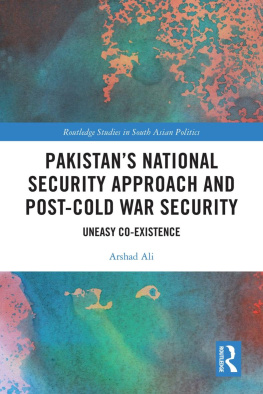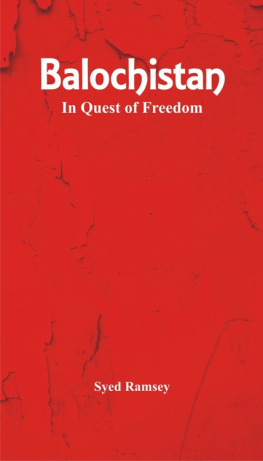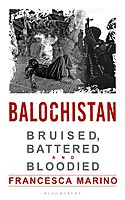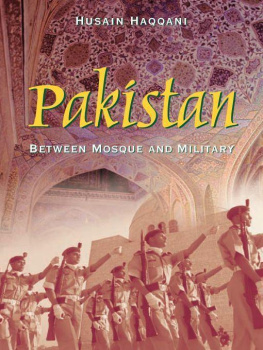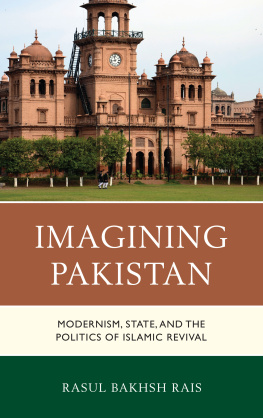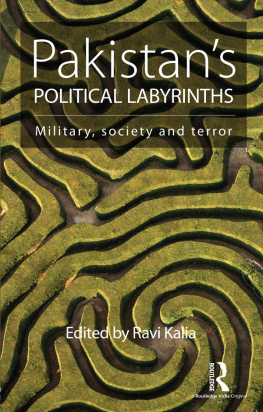The Genesis of Baloch Nationalism
This book explores the ideological, political and military interventions of the state of Pakistan in Balochistan and traces the genesis of todays secessionist movement. It delves into the historical question of Balochistans integration into Pakistan in 1947 and brings out the true political and militant character of the movement during the first three decades (194777) of Pakistans existence as a nation-state. It shows how the Baloch, as well as other minority groups, were denied the right to identify themselves as a sub-national/ethnic group in the new nation-state, compounded by a systematic exclusion from decision-making circles and structures of political and economic power. The volume also traces political resistance from within Balochistan and its subsequent suppression by military operations, leading to a widespread militant insurgency in the present day.
Drawing on hitherto unexplored sources, this book will be indispensable to scholars and researchers of South Asian history, politics, international relations and area studies.
Salman Rafi Sheikh, previously a research scholar at the National Institute of Pakistan Studies, Quaid-i-Azam University, Islamabad, Pakistan, is by training a political scientist, specializing in political history with focus on ethno-nationalism, identity politics and post-colonialism. He writes on Pakistans various socio-political issues, foreign policies of major powers towards regional issues, including Balochistan, their application and consequences, and his op-eds and insights regularly appear in highly acclaimed international and regional media such as Asia Times.
Salman Rafi has written a book that should make all of us pause and contemplate the complex realities of political conflict in the contemporary world. In meticulously documenting the evolution of the political struggle of the Baloch ethnic-nation for rights and recognition within the state of Pakistan, Rafi forces us to think critically about the problem of political violence in the so-called age of terror and alerts us to the dangers of using an ahistorical lens to study conflicts between states and ethnic communities that reside within state borders. Rafi demonstrates that the growing visibility of often-violent separatist elements within the wider Baloch nationalist movement raises questions about how successive Pakistani rulers have dealt with long-standing demands emanating from peripheral regions over questions of identity and power-sharing within a multi-national state. Rather than embodying a fundamentally anti-democratic and violent ethos, the Baloch movement is, in Rafis close reading, to be seen as a case of a people being forced into an untenable position by a state that continues to view democratic assertion by historically underrepresented ethnic groups as an invitation to suppress them. Needless to say, such an approach by the state is entirely self-defeating, but, worryingly, more and more the norm in an age where any and all forms of dissent are conveniently reduced to terrorism.
Aasim Sajjad Akhtar
National Institute of Pakistan Studies, Quaid-i-Azam University, Islamabad
The Genesis of Baloch Nationalism
Politics and Ethnicity in Pakistan, 19471977
Salman Rafi Sheikh

First published 2018
by Routledge
2 Park Square, Milton Park, Abingdon, Oxon OX14 4RN
and by Routledge
711 Third Avenue, New York, NY 10017
Routledge is an imprint of the Taylor & Francis Group, an informa business
2018 Salman Rafi Sheikh
The right of Salman Rafi Sheikh to be identified as author of this work has been asserted by him in accordance with sections 77 and 78 of the Copyright, Designs and Patents Act 1988.
All rights reserved. No part of this book may be reprinted or reproduced or utilised in any form or by any electronic, mechanical, or other means, now known or hereafter invented, including photocopying and recording, or in any information storage or retrieval system, without permission in writing from the publishers.
The map included in the volume is archival content; the international boundaries, coastlines, denominations, and other information shown in the map in this work do not necessarily imply any judgement concerning the legal status of any territory or the endorsement or acceptance of such information.
Trademark notice: Product or corporate names may be trademarks or registered trademarks, and are used only for identification and explanation without intent to infringe.
British Library Cataloguing-in-Publication Data
A catalogue record for this book is available from the British Library
Library of Congress Cataloging-in-Publication Data
A catalog record has been requested for this book
ISBN: 978-1-138-05541-4 (hbk)
ISBN: 978-1-351-02070-1 (ebk)
Typeset in Galliard
by Apex CoVantage, LLC
TO MY PARENTS, MY WIFE AND MY DAUGHTER
Contents
This volume has been in the making since 2013 when I got enrolled in the National Institute of Pakistan Studies (N.I.P.S.) at Quaid-i-Azam University, Islamabad, for an M.Phil. programme. Although originally my research thesis, it has ever since evolved into a work that marks, besides being an academic exercise, a personal insight into perhaps one of the least understood and known regions of Pakistan, Balochistan. Until my encounter with the picture of Balochistan that, even today, cannot be seen in any of the official history textbooks, Balochistan for me was only a remote region of Pakistan beset by secessionist sentiments fuelled by some stubborn sardars for their personal political ambitions. The pervasive power of the official narrative of Pakistan about Balochistan cannot be denied, nor can we disregard it as simply irrelevant to developing a sound understanding of the nature of the problem. For me, it is this official narrative and the specific yet self-contradictory view constructed in it that turned into the primary source of motivation for systematically exploring why Balochistan, despite being rich in resources, remains the most impoverished and the most troubled region of Pakistan. The official narrative erroneously pins the responsibility on the stubborn and troublesome sardars and, as some recent developments have shown, on foreign powers. And in doing that, this narrative tactfully tends to help the state escape the responsibility for the mess that Balochistan today is. This contradiction, for me and for many others, is a conundrum that points to Balochistan being a much bigger and a complex problem than meets the eye, needing a systematic investigation.
Research for this volume took place in a number of institutes, both public and private, having significant collections of archives. Apart from utilizing the vast database of the National Documentation Centre (N.D.C.) located in the Cabinet Division office in Islamabad, National Archives in the Pakistan Secretariat in Islamabad and the libraries of National Assembly of Pakistan, where the chief librarian Mr. Haji Hattar was of immense help, and the Senate in Islamabad and the library of Punjab Assembly in Lahore, material collected from Balochistan Archives in Quetta was of primary significance in terms of providing a useful insight into the various dynamics of the Baloch question.
An important avenue of research was South Asian Research and Resource Centre, a private archive established in Islamabad in 2001. It was here, courtesy of the poet-activist and researcher Mr. Ahmad Salim, that I was able to have access to one of the most important and critical sources of information that this research has utilized: secret bulletins of the Baloch insurgent groups. These groups issued these bulletins, written in both English and Urdu, on a monthly basis during the 197377 insurgency. It was through these bulletins that I was able to grasp the inner dynamics of the movement, of the insurgencies and of the very objectives they were pursuing until 1977. I am indeed deeply thankful to Mr. Ahmad Salim and his staff for facilitating this work at this research centre and for helping me explore other resource centres as well.




